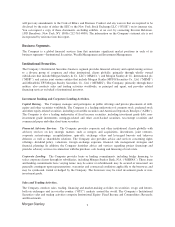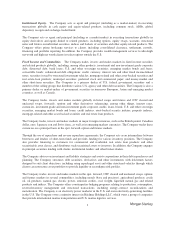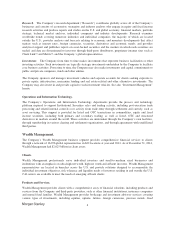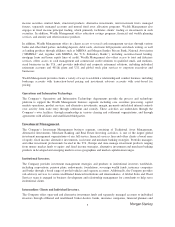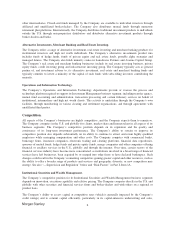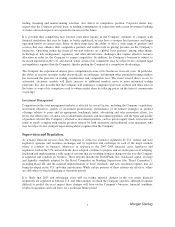Morgan Stanley 2014 Annual Report Download - page 16
Download and view the complete annual report
Please find page 16 of the 2014 Morgan Stanley annual report below. You can navigate through the pages in the report by either clicking on the pages listed below, or by using the keyword search tool below to find specific information within the annual report.
The capital plan must include a description of all planned capital actions over a nine-quarter planning horizon,
including any issuance of a debt or equity capital instrument, any capital distribution (i.e., payments of dividends
or stock repurchases), and any similar action that the Federal Reserve determines could impact the bank holding
company’s consolidated capital. The capital plan must include a discussion of how the bank holding company
will maintain capital above the minimum regulatory capital ratios, including the minimum ratios under U.S.
Basel III that are phased in over the planning horizon, and above a Tier 1 common risk-based capital ratio of 5%,
and serve as a source of strength to its subsidiary U.S. depository institutions under supervisory stress scenarios.
The capital plan rule requires that such companies receive no objection from the Federal Reserve before making
a capital distribution. In addition, even with an approved capital plan, the bank holding company must seek the
approval of the Federal Reserve before making a capital distribution if, among other reasons, the bank holding
company would not meet its regulatory capital requirements after making the proposed capital distribution. In
addition to capital planning requirements, the OCC, the Federal Reserve and the Federal Deposit Insurance
Corporation (“FDIC”) have the authority to prohibit or to limit the payment of dividends by the banking
organizations they supervise, including the Company and its U.S. Subsidiary Banks, if, in the banking regulator’s
opinion, payment of a dividend would constitute an unsafe or unsound practice in light of the financial condition
of the banking organization. All of these policies and other requirements could affect the Company’s ability to
pay dividends and/or repurchase stock, or require it to provide capital assistance to its U.S. Subsidiary Banks
under circumstances which the Company would not otherwise decide to do so.
In addition, the Federal Reserve’s final rule on stress testing under the Dodd-Frank Act requires the Company to
conduct semi-annual company-run stress tests. The rule also subjects the Company to an annual supervisory
stress test conducted by the Federal Reserve. On January 5, 2015, the Company submitted the results of its semi-
annual stress test to the Federal Reserve.
The Company expects that, on March 11, 2015, the Federal Reserve will provide its response to the Company’s
2015 capital plan (that was submitted to the Federal Reserve on January 5, 2015). The Company received no
objection to its 2014 capital plan (see “Management’s Discussion and Analysis of Financial Condition and
Results of Operation—Liquidity and Capital Resources—Capital Management” in Part II, Item 7).
The Dodd-Frank Act also requires each of the Company’s U.S. Subsidiary Banks to conduct an annual stress test.
MSBNA submitted its 2015 annual company-run stress tests to the OCC on January 5, 2015. MSPBNA will
submit its 2015 annual company-run stress tests in March 2015.
See also “—Capital and Liquidity Standards” above and “Management’s Discussion and Analysis of Financial
Condition and Results of Operation—Liquidity and Capital Resources—Regulatory Requirements” in Part II,
Item 7.
Systemic Risk Regime. The Dodd-Frank Act established a regulatory framework applicable to financial
institutions deemed to pose systemic risks. Bank holding companies with $50 billion or more in consolidated
assets, such as the Company, became automatically subject to the systemic risk regime in July 2010. A new
oversight body, the Financial Stability Oversight Council (the “FSOC”), can recommend prudential standards,
reporting and disclosure requirements for systemically important financial institutions to the Federal Reserve.
The FSOC is also empowered to designate systemically important payment, clearing and settlement activities of
financial institutions, subjecting them to prudential supervision and regulation and, assisted by the new Office of
Financial Research within the U.S. Department of the Treasury (“U.S. Treasury”) (established by the Dodd-
Frank Act), can gather data and reports from financial institutions, including the Company.
The systemic risk regime established by the Dodd-Frank Act, provides that, if the Federal Reserve determines
that a systemically important financial institution poses a “grave threat” to U.S. financial stability, the Federal
Reserve, with the FSOC’s approval, must limit that institution’s ability to merge, restrict its ability to offer
financial products, require it to terminate activities, impose conditions on activities or, as a last resort, require it
to dispose of assets. The Federal Reserve also has the ability to establish further standards, including those
12


